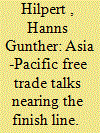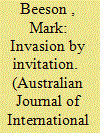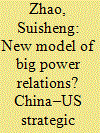| Srl | Item |
| 1 |
ID:
138926


|
|
|
|
|
| Summary/Abstract |
Asia is not only the world’s most dynamic region in terms of trade, it is also an important pacesetter in trade policy. The USA is currently negotiating with 11 partner countries over a Trans-Pacific Partnership (TPP); the members of the ASEAN+6 group are in talks over a Regional Comprehensive Economic Partnership (RCEP), while Japan, China and Korea are conducting trilateral trade negotiations (China-Japan-Korea Free Trade Agreement (CJK FTA)). The multilateral structures emerging from all these initiatives could, in the long term, be combined into a Free Trade Area of the Asia-Pacific (FTAAP). What are the motives behind these agreements? What are their chances of being implemented? When it comes to the trade and geopolitical power struggle that encompasses these talks, does the USA or China have the upper hand? And what role remains for Europe’s trade policy?
|
|
|
|
|
|
|
|
|
|
|
|
|
|
|
|
| 2 |
ID:
138958


|
|
|
|
|
| Summary/Abstract |
Alliances continue to occupy a prominent place in the Asia-Pacific's security architecture. For many regional states such as Australia and Japan, their respective alliances with the USA are the unchallenged foundations of their security. But when the rise of China is causing major change in the region, and when many countries are increasingly reliant on China economically, is the region's network of alliances any longer appropriate or useful? This article reviews alliances in theory and practice, and argues that, while alliances are unlikely to disappear, their utility is nothing like as clear-cut as many of their supporters would have one believe.
|
|
|
|
|
|
|
|
|
|
|
|
|
|
|
|
| 3 |
ID:
137496


|
|
|
|
|
| Summary/Abstract |
Exploring the causes of the China–US strategic rivalry and its possible mitigation, this article argues that President Xi's new model of big power relations represents a challenge to the US primacy in the Asia–Pacific based on China's rising power and deeply rooted suspicion of the US containment. But neither the US nor China can be the single dominant power in the region. The new model can be built only if China and the US demonstrate a strategic restraint and maintain a delicate balance of power to prevent their rivalry from boiling over into a new Cold War.
|
|
|
|
|
|
|
|
|
|
|
|
|
|
|
|
| 4 |
ID:
138862


|
|
|
|
|
| Summary/Abstract |
The ascendance of Narendra Modi to the post of India’s Prime Minister comes at a time when Asian geopolitics is in a state of flux. The rise of an assertive China and the resurgence of Japan under Shinzo Abe uniquely positions India as a stable, democratic force that the U.S. and Japan could partner with in order to maintain influence in the Asia-Pacific. India’s rise as a major power promises to transform the Asian security architecture from a purely Asia-Pacific security system to a broader “Indo-Pacific” framework, which includes India. However, settling the sub-continental fronts with Pakistan and Afghanistan will be critical for New Delhi to direct its resources to other regional fronts with China and beyond the Straits of Malacca. It is in this context that both Washington and New Delhi can coordinate their efforts to achieve a common security objective in the subcontinent and support India’s economic rise that complements U.S.’ pivot to Asia. An enhanced economic and security relationship with Washington can bolster India’s engagement with Asia and provide New Delhi an opportunity to be a part of a multilateral hedging system that strengthens its bilateral position vis-à-vis China and its South Asian neighbours. Yet, even as India strives closer to the U.S. and Japan, it will refrain from forging an overt security alliance under a U.S.-led architecture and continue to engage in a hedging policy to maintain maximum freedom of diplomatic maneuver.
|
|
|
|
|
|
|
|
|
|
|
|
|
|
|
|